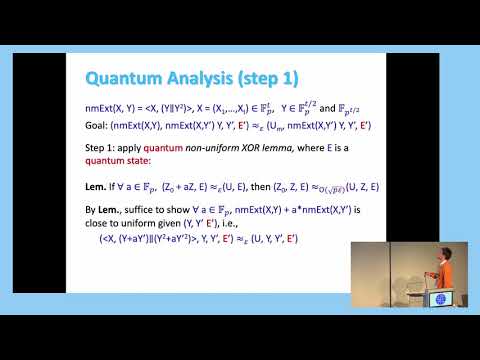CryptoDB
A Quantum-Proof Non-malleable Extractor
| Authors: | |
|---|---|
| Download: |
|
| Abstract: | In privacy amplification, two mutually trusted parties aim to amplify the secrecy of an initial shared secret X in order to establish a shared private key K by exchanging messages over an insecure communication channel. If the channel is authenticated the task can be solved in a single round of communication using a strong randomness extractor; choosing a quantum-proof extractor allows one to establish security against quantum adversaries.In the case that the channel is not authenticated, this simple solution is no longer secure. Nevertheless, Dodis and Wichs (STOC’09) showed that the problem can be solved in two rounds of communication using a non-malleable extractor, a stronger pseudo-random construction than a strong extractor.We give the first construction of a non-malleable extractor that is secure against quantum adversaries. The extractor is based on a construction by Li (FOCS’12), and is able to extract from source of min-entropy rates larger than 1 / 2. Combining this construction with a quantum-proof variant of the reduction of Dodis and Wichs, due to Cohen and Vidick (unpublished) we obtain the first privacy amplification protocol secure against active quantum adversaries. |
Video from EUROCRYPT 2019
BibTeX
@article{eurocrypt-2019-29368,
title={A Quantum-Proof Non-malleable Extractor},
booktitle={Advances in Cryptology – EUROCRYPT 2019},
series={Advances in Cryptology – EUROCRYPT 2019},
publisher={Springer},
volume={11477},
pages={442-469},
doi={10.1007/978-3-030-17656-3_16},
author={Divesh Aggarwal and Kai-Min Chung and Han-Hsuan Lin and Thomas Vidick},
year=2019
}

